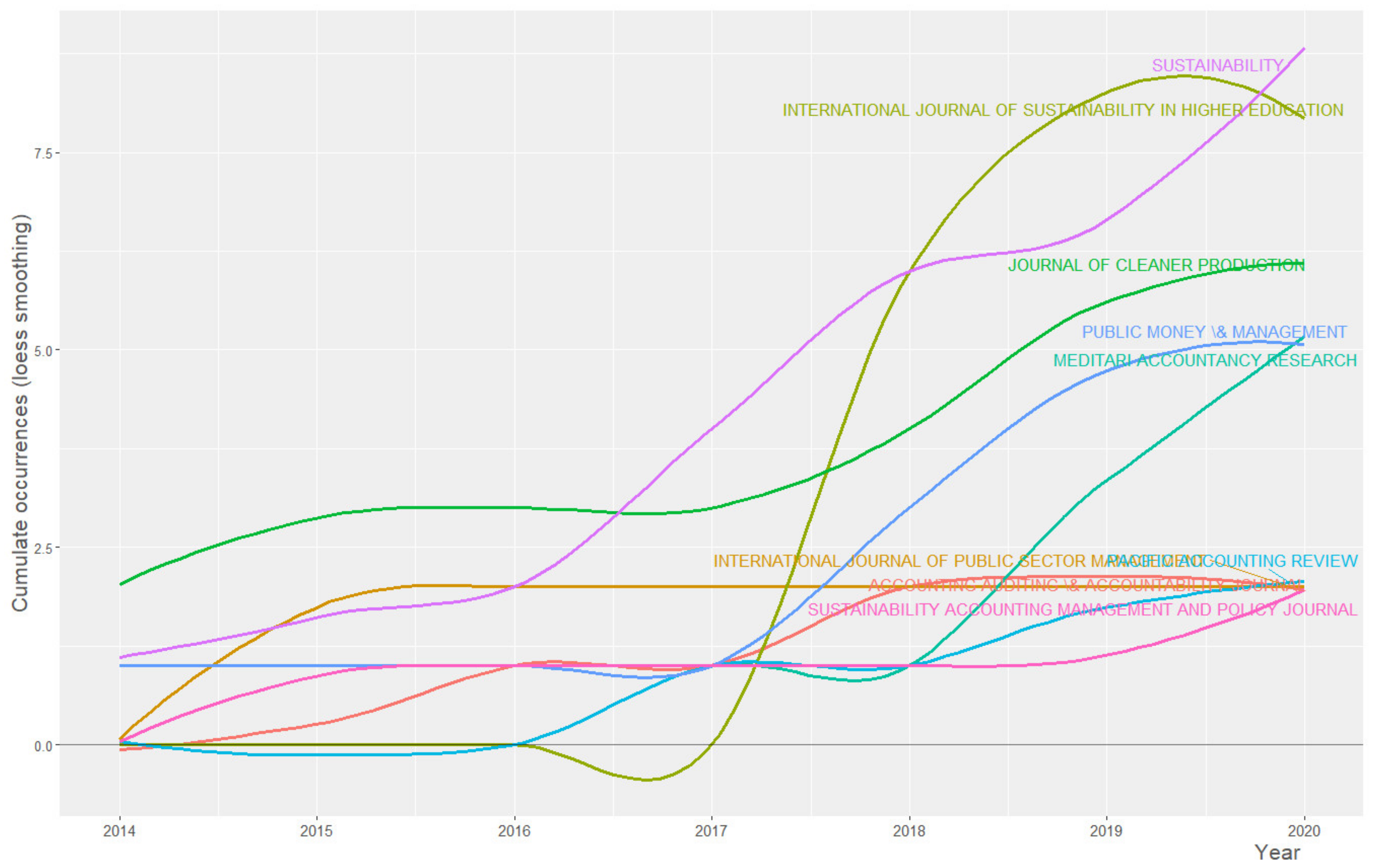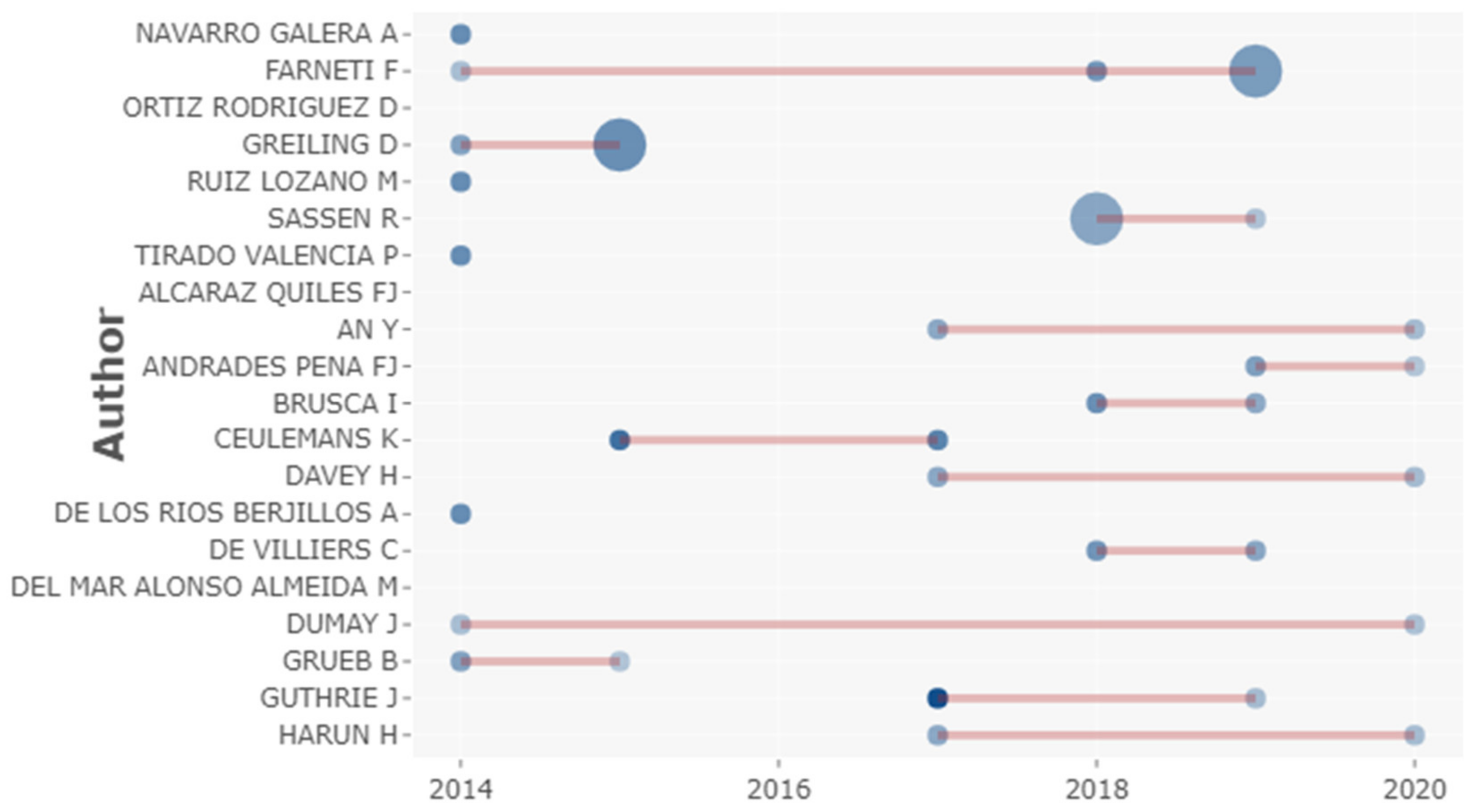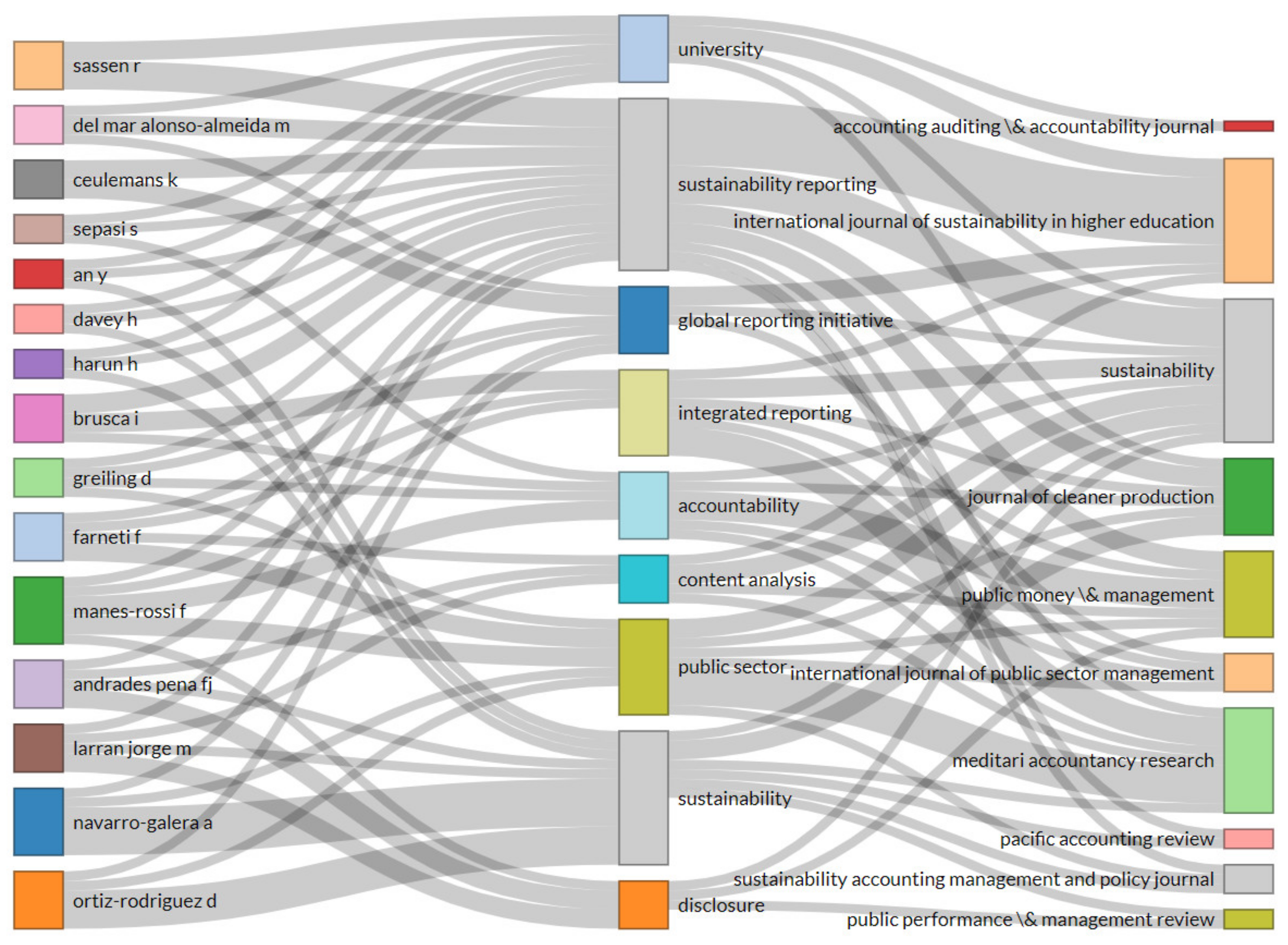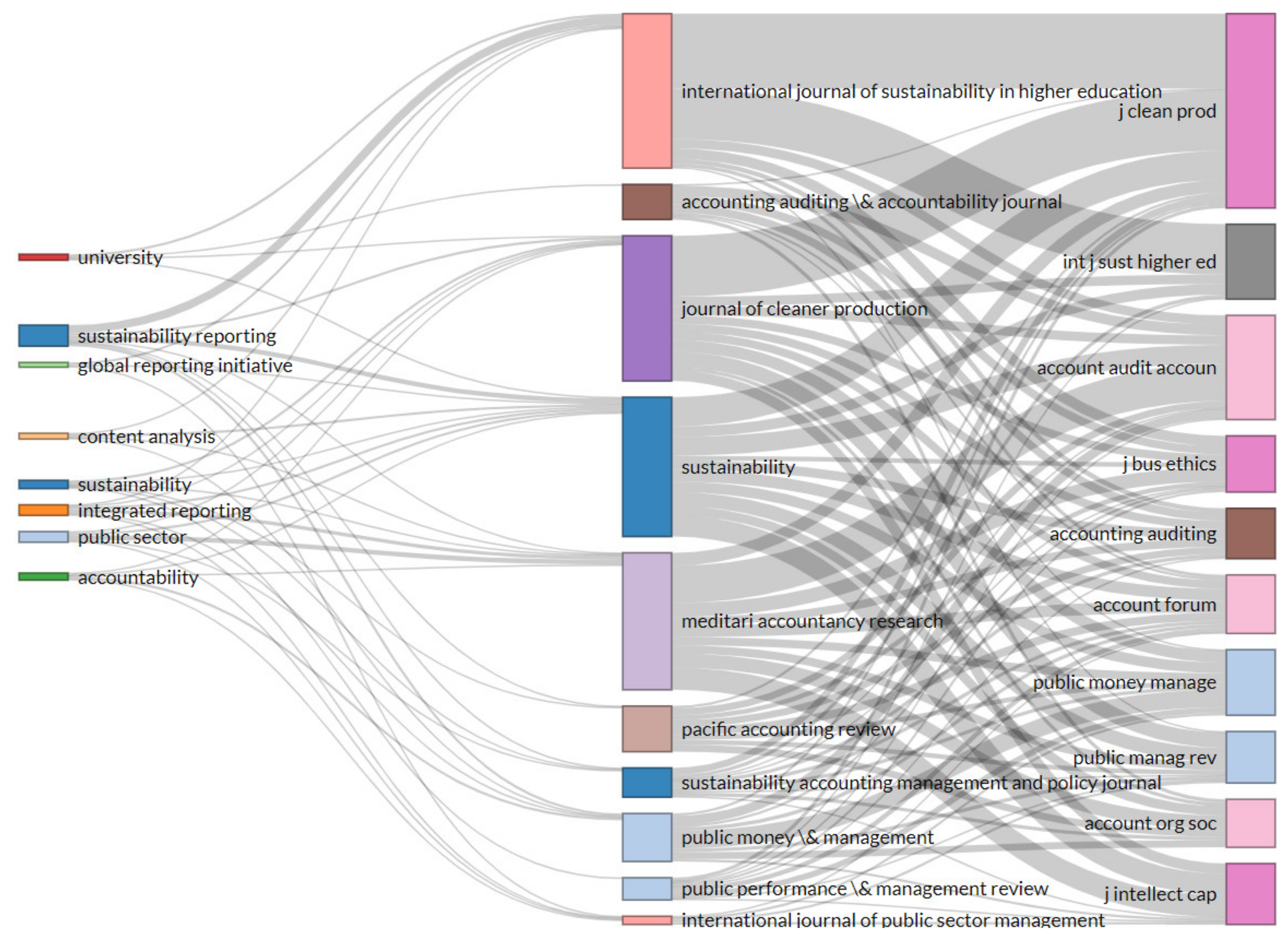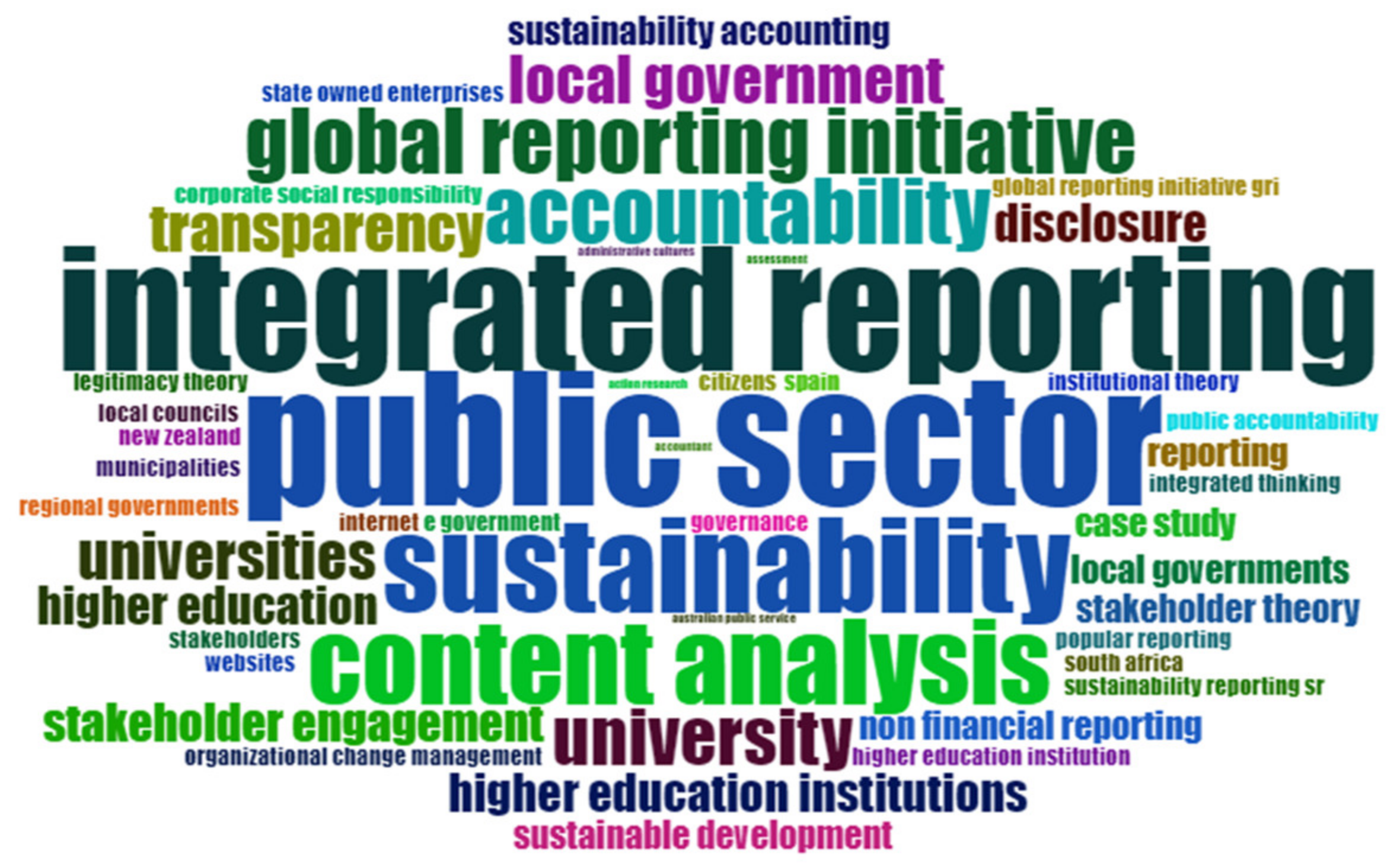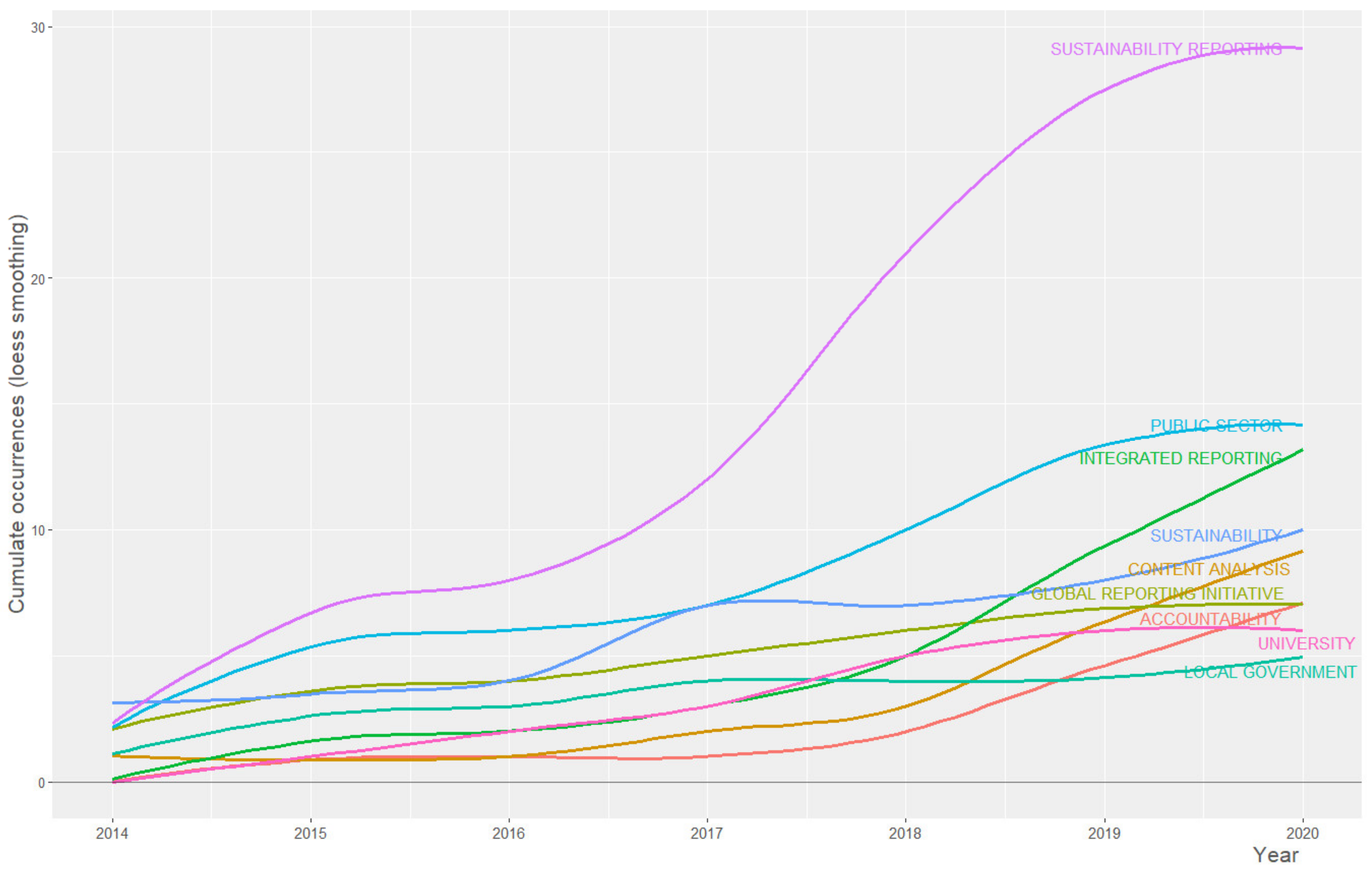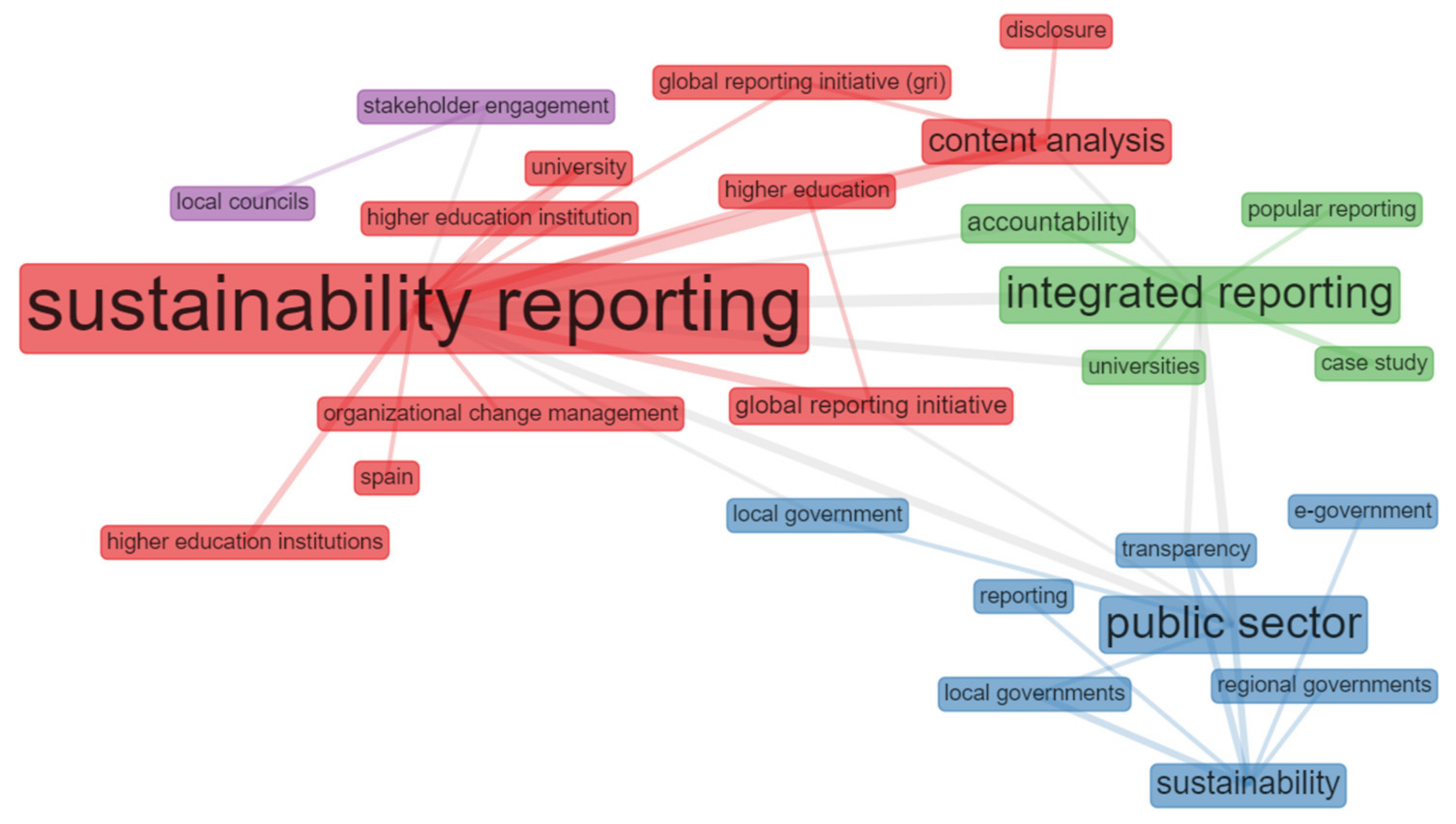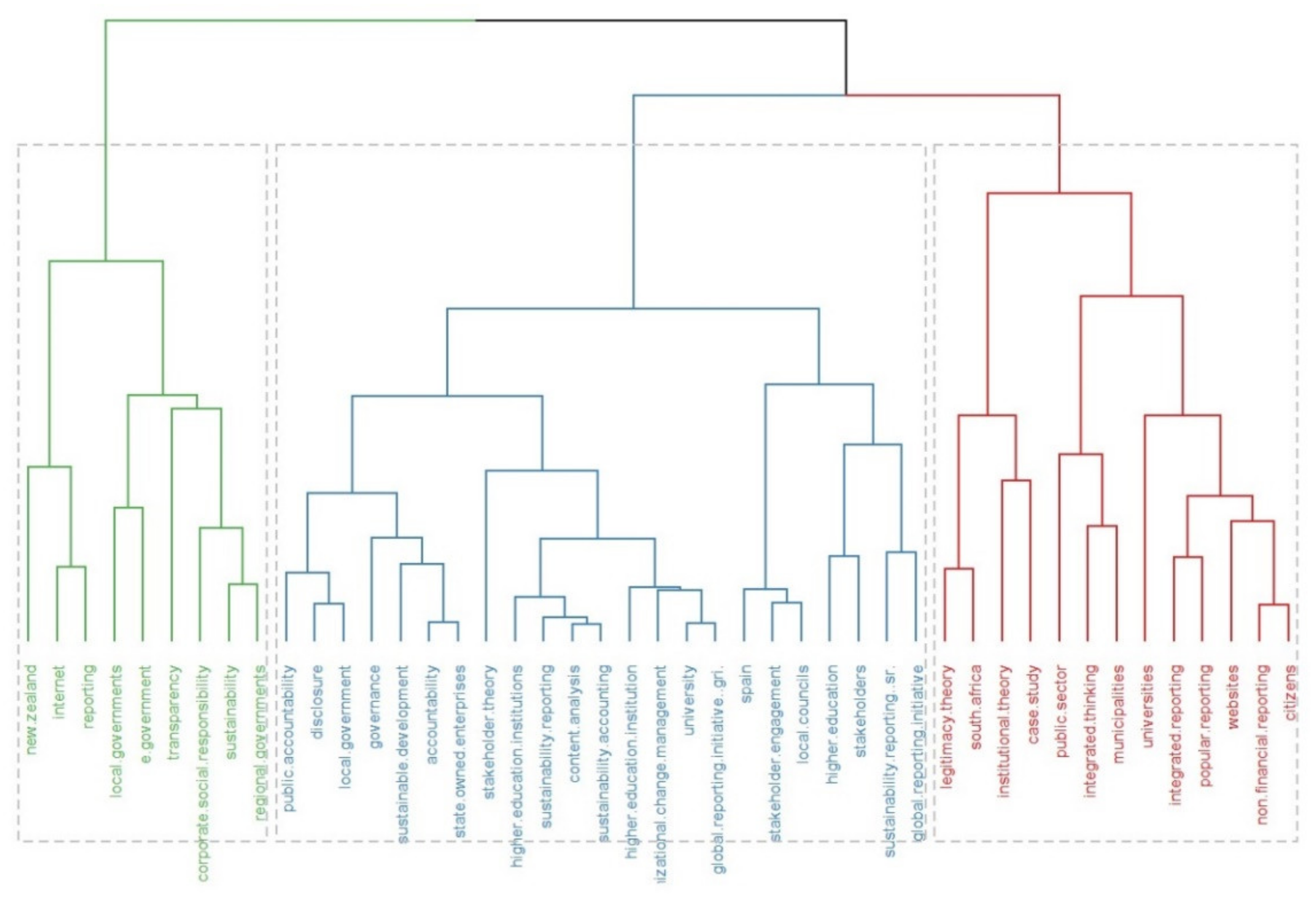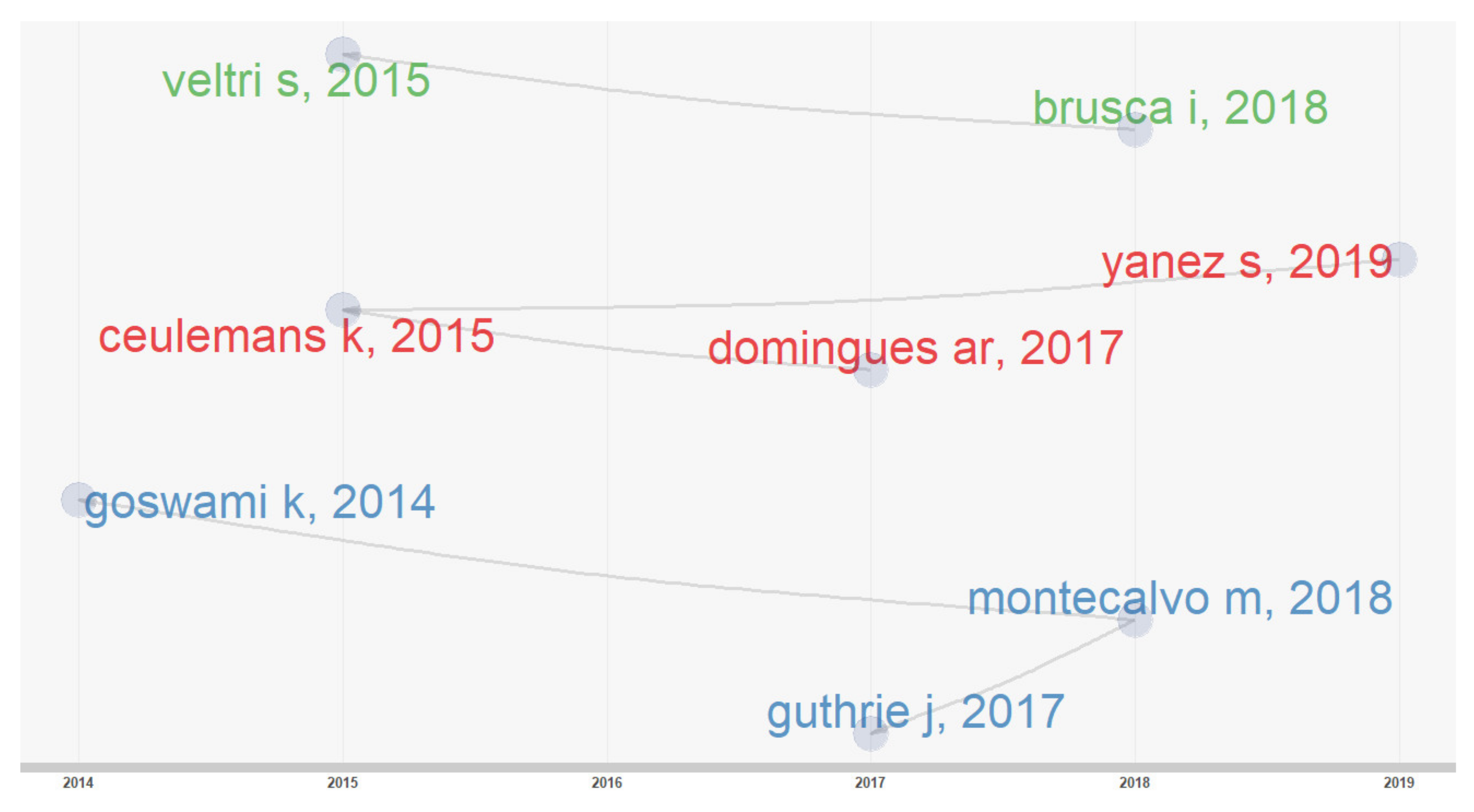3.1. Overview, Growth Trend and Geographical Distribution
During the period studied, 44 journals published, at least one of the 79 scientific papers of our analyzed sample, were the result of the contribution of 172 authors.
Figure 1 displays the size, growth trend and distribution of sustainability reporting research in the public sector over the timespan. As can be seen, the evolution was quite unsteady, with its peak reached in the year 2019 when 19 papers were published. The uncertain trend reveals that the research literature in this particular field is far from sufficiently explored. Thus, it leaves room for in-depth research paths.
The geographical distribution of sustainability reporting literature in the public sector is presented in
Table 3 through the top-10 countries that not only heavily researched this topic, but whose relevant results became highly cited. The number of papers and citations was calculated considering the involvement in the authorship of a country. In the case of authors from different countries, each of them had a point. The majority of contributions within the sampled studies came from Spain and Italy (37.97%), whose researchers were already recognized for their interest in non-financial reporting, motivated by the transparency legislation issued in both countries [
17]. Australian scholars not only seem to significantly contribute to the topic analyzed (17.72%), but they also stood in the second position (after Spain) in terms of citations.
An in-depth analysis of scholars’ academic affiliations are presented in
Table 4, where there are lists of all the universities whose researchers have published more than two papers using the fractional counting method. It is noteworthy that most of them are from Spain and Italy. These results confirm the country affiliation of the most productive authors.
However, both
Table 3 and
Table 4 also show an interesting outcome there are also emerging economies within the most productive countries (e.g., China and Iran). This conclusion is consistent with the previous literature [
16], confirming the consequences of the research funding support received.
In conclusion, even though there is a degree of diversity of authors’ nationality, the analyzed literature is concentrated on a small number of countries and most of the papers were the product of a co-authorship, only few being single-authored documents (11 papers). Thus, the research field approached seems quite enclosed, but extensively explored.
3.2. Leading Journals, Authors and Papers
- (a)
Journals
The top ten sources encompass more than half (53.16%) of the scientific production in the researched field, almost a third (29.11%) being published in ‘top three’ journals (see
Table 5). Despite its newness in the WoS database, being quoted with a 5-Year Impact Factor only since 2016, sustainability is in the first place as regards the papers published. It also holds the second position from the perspective of citations (116 citations), surpassed by the Journal of Cleaner Production (202 citations). Moreover, it is worth mentioning that, of the 44 journals, 35 (almost 80%) have only published one document related to this topic, while the other nine journals cover approximately half of the entire papers analyzed. Besides, these journals either concentrate on the accounting research area and public management or focus directly on sustainability-related issues.
However, the dynamic of the top journals (see
Figure 2) show that internationally recognized generalist journals, such as Sustainability, Journal of Cleaner Production and Meditari Accountancy Research, recently recorded an upward trend in publications. It reveals that public sector studies have gradually spread worldwide, going beyond specialist journals such as Public Money and Management or International Journal of Public Sector Management. It also highlights the increasing importance of non-financial issues, such as sustainability reporting in the public sector.
Moreover, the very diverse nature of journals is noteworthy and is interested in publishing papers approaching sustainability reporting in the public sector (see
Table 6). An analysis of the WoS categories to which the journals belong, considering that a multidisciplinary journal may appear in more than one category, reveals that the principal one is ‘Green and Sustainable Science and Technology’, with almost a quarter of papers published. It was expected since this category encompasses journals focused directly on the general topic of sustainability (Sustainability, International Journal of Sustainability in Higher Education, Journal of Cleaner Production, Sustainability Accounting Management and Policy Journal, and Sustainable Development). As for the rest of the WoS categories encountered, there is a relatively balanced distribution among them. It confirms that sustainability reporting in the public sector became a research topic that raised interest in all categories, apart from ‘Public Administration’.
To identify the influential sources on the sustainability reporting literature in the public realm, we presented the most cited journals within the literature analyzed. As
Table 7 presents, these were mainly from high-quality journals, with the breadth of publishing scholarship in this field being diverse.
The leading cited journal is, by far, the Journal of Cleaner Production, aimed at helping societies become more sustainable. It offers broad coverage of various international trans-disciplinary perspectives on environmental and sustainability research and practice. However,
Table 7 also suggests that, besides sources directly focused on sustainability issues included in environmental categories (Sustainability, Sustainability Accounting Management and Policy Journal), journals from various fields of business, finance, management or public administration emerged in the topmost cited sources. It once more highlights the widespread interest in approaching sustainability reporting. Besides, within the top five journals, there are two from educational studies (International Journal of Sustainability in Higher Education), respectively, ethics (Journal of Business Ethics), which reveals the importance of higher education and ethical issues in promoting sustainability reporting in the public sector. Finally, when comparing
Table 5 (top journals within the samples analyzed) with
Table 7 (most cited sources), we identified eight matches between them, which better underlines their contribution to this research stream.
In conclusion, even though the topic approached is a narrow one, as it focuses on a specific reporting (sustainability) in a particular realm (public sector), there was a strong interest in approaching the subject from journals that are not dedicated to any of these, meaning that sustainability reporting in the public sector became an issue of great importance.
- (b)
Authors
To analyze the leading scholars that contributed to the sustainability reporting literature in the public sector, we looked into the number of documents published and citations (see
Table 8). 172 authors gave their contribution to this field (2.26 authors per paper). Most of the papers (more than 85%) are the product of co-authorship, and almost half of the multi-authored ones (42.42%) are the result of cooperation between scholars from different countries. The highest frequency of collaboration (four papers) was encountered between Italy and Australia. Moreover, it appears that there is a high degree of diversity when it comes to the authors’ nationality, as they come from 21 countries. However, the relevant literature is concentrated in a few countries and among a few authors.
Thus, most leading scholars are geographically from Europe (e.g., Spain, Austria, Italy, Germany, Portugal, and Belgium) or Oceania (Australia and New Zeeland). The dominant authors that contributed to the sustainability reporting literature in the public sector are Navarro Galera and Farneti (five and four papers, respectively), representing Spain and Italy, countries already recognized for their interest in non-financial reporting [
17]. Concerning the author’s impact, Farneti remains on top as the single researcher with the highest H-Index, while Ceulemans encountered the highest number of total citations.
Finally, the top authors’ production over time (see
Figure 3) reflects the breadth, quality and other potential scholars, thus providing insight for future research. It reveals that, even though, in the beginning, there were several occasional interests in this topic, the relevance increased over time. Moreover, the attention to the issue remained constant, especially between 2017 and 2020, thus highlighting their increasingly active role in promoting sustainable reporting in a particular realm, namely the public sector.
To sum up, despite the unsteady trend of research in this particular realm, marked in the beginning by several occasional studies, its relevance increased over time due to the widespread interest in approaching this topic, especially in European countries, followed by Australia and New-Zeeland, and the support of various journals from the economic fields, not just from those directly focused on sustainability issues.
- (c)
Papers
The analysis of the leading papers in the sustainability reporting literature focused on the public sector is based on the number of citations per year (see
Table 9), as it reveals the papers’ impact, most accurately considering the amount of time to receive quotes [
28]. Evidence demonstrates that the most cited article is of Del Mar Alonso-Almeida et al. [
30] regarding the diffusion of sustainability reporting in universities dating back to 2015. At the same time, this is the first paper in the ‘citations per year’ ranking. Within the most cited articles, journals from the top ones are predominant (
Table 5 and
Table 7). Thus, the four most cited papers were published by the Journal of Cleaner Production, which is the most cited and third most productive journal. Even though older articles are often better known and consolidated in the literature, among the top five most cited papers prevails over the newer ones (published in 2017 and 2019). It confirms that there is an emerging research agenda in the public sector approaching sustainability reporting [
17].
Moreover, it can be seen that, although there are numerous specialist journals in the public sector, the most cited papers have mainly been published in sources belonging to the ‘environmental sciences/studies’ categories, while those published in the ‘public administration’ journals occupied the last two positions. This phenomenon emphasizes the growing consideration in approaching the subject from journals that are not specialized in a particular realm, meaning that sustainability reporting in the public sector is an issue of great importance.
Finally, highly cited papers were by far dominated by studies covering sustainability and integrated reporting research topics. Most of them focused on a facet of the public sector, mainly higher education and local government.
- (d)
Top journals, authors and keywords relations
To analyze the connections between the most important scientific fields, we visualize them using Three Field Plots. These allowed us to simultaneously analyze the main items from the selected fields (journals, authors, papers’ keywords, cited journals) and to interpret how they are related, based on a Sankey diagram. It depicts the relevant items by differently colored rectangles that are proportional to the value of relations aroused between them [
20].
Figure 4 shows the representative scholars in sustainability reporting, the frequently explored areas in the public sector and where they are most published, by visualizing the relations between authors (left side), the paper’s keywords (middle side) and journals (right side). The analysis reveals that, besides sustainability reporting, which was by far the most approached, it was the central topic of this study, and the authors also paid attention to specific reports defined by <IR> [
5,
7,
13] or GRI frameworks [
8,
30,
31,
32,
33,
34]. Most of their scientific work was disseminated by top productive sources (Sustainability, International Journal of Sustainability in Higher Education, Journal of Cleaner Production and Meditary Accountancy Research). Moreover, particular issues related to sustainability have also been approached, such as accountability [
5,
8,
15,
35] and disclosure [
12,
13,
36], mostly published in public thematic journals (Public Money and Management, International Journal of Public Sector Management, Public Performance and Management Review). Besides, there was a high focus on studying the topic in a particular public sector area, namely higher education, since universities were, by far, frequently approached [
8,
15,
30,
31,
37,
38,
39].
Besides, we analyzed the structure of top publishing sources (such as journals and cited journals) in developing knowledge on the main topics of sustainability reporting in the public sector.
Figure 5 shows the relations between papers’ keywords (left side), journals (middle side) and cited journals (right side). This analysis reveals frequent and stronger connections between the publishing and cited journals, some of them belonging to both sides (International Journal of Sustainability in Higher Education, Journal of Cleaner Production, Accounting Auditing and Accountability Journal, Public Money and Management).
3.3. Network Analysis
We firstly analyzed the most frequently used words and keywords and their dynamics across our timespan, which allowed us to visualize the trend topics thematically related in this field. Afterwards, we deepened our research by clustering the most commonly used keywords. Thus, we analyzed the co-occurrence networks developed, mapped them thematically and visualized the conceptual structure through the topic dendrogram. Finally, we approached the intellectual structure as well, by performing the co-citation analysis, including historiographic parameters.
- (a)
Words and keywords analysis
“WordCloud” highlights the most common words in the researched literature through their dimension in the image, which represents the magnitude of the recurrence of the same words within the sample papers [
4,
25]. As
Figure 6 shows, the keywords of this bibliometric study are “public sector”, “sustainability” and “integrated reporting”, located in the map center. Subsequently, words such as “global reporting initiative”, “accountability”, and “content analysis” were also recurring in most papers.
To further study the themes addressed in this research field, an analysis of the most frequent words related to the sampled papers was carried out (see
Table 10). In line with prior literature [
20,
23], the authors’ keywords, as well as words in the abstracts and titles were considered to be representative terms for the themes studied. The analysis was based on the number of relevant wording occurrences in the papers under consideration. While the key-topics of the publications analyzed were issues related to sustainability reporting in the public sector, the total occurrences of author keywords were much fewer than the number of articles due to the wide variety of reporting formats used by authors. However, at first glance, we can see that, among the frameworks approached, closely related to sustainability reporting, there are both <IR> and GRI, while focus was equally directed towards both universities and local governments. Moreover, it is worth mentioning that the last terms among the top 10 are ‘transparency’ and ‘disclosure’, which reveal that studies were trying to shed light on the emerging reporting trend in the public sector, looking for the potential to promote accountability and transparency. Thus, it suggests that the literature responded to the need to acknowledge public organizations’ role in advancing non-financial reporting [
9].
Based on the bibliometric analysis, a graph relating to the dynamic growth of the keywords most commonly used by the authors was reconstructed (
Figure 7), showing the co-occurrence of their frequency per year. We chose the keywords since they are used by authors, editors and publishers to signal important themes in articles [
40], and their analysis is focused on small amounts of material in considerable depth [
41].
It is interesting to note that the term ‘sustainability reporting’ recorded significant growth in recent years. It is explained by the latest initiatives in this field (e.g., the adoption of the SDGs, the national transposition of the Directive 95/2014/EU) that intensified scholars’ interest, too. Moreover, it can be noticed a shift in researchers’ interest between GRI and <IR> as a framework for sustainability reporting. Besides, their focus oscillated between local governments and universities as public sector organizations. These results are consistent with prior scholars’ doubts regarding the appropriateness of using GRI standards, as the supplement for the public sector does not fulfil the reporting duties, thus recalling the concept of integrated thinking [
17]. Besides, they acknowledged the potential of higher education institutions as a “force for change” to stimulate sustainable development and reporting [
3].
More insights on how sustainability reporting in the public sector has attracted growing interest and research focus are provided by the evolution of the top-trend topics over the last few years [
22]. As it can be seen, the central topic of the sampled papers is sustainability and its related reporting, analyzed along time either generally in the public sector, or particularly in local governments, and more recently, focused on higher education.
Figure 8 also highlights the change in the trend of the reporting issues across the period analyzed. However, even though the researchers’ approaches of sustainability reporting evolved along with the continuous development of the related voluntary frameworks (e.g., GRI, <IR>), they still leave room for future studies on the first mandatory regulation of non-financial information disclosure (Directive 95/2014/EU).
- (b)
Co-keywords analysis
To visualize the research hotspots in sustainability reporting literature in the public sector, we employed a co-occurrence network analysis of authors’ keywords (see
Figure 9). This method was useful to identify the relationships between concepts in a research field, thus observing how the science developed towards specific themes [
20,
21,
23,
24,
25].
The size of the labels in
Figure 9 represent their relative importance and correspond to the number of occurrences of the keywords calculated using the degree of centrality measure; thus, the larger ones mean connections to more papers.
The keyword co-occurrence network emphasizes the close interrelations among the topics covered in this review, highlighting how the perspective of ‘sustainability reporting’ and ‘integrated reporting’ refers to the general notion of ‘sustainability in the public sector’ and its related organizations, and vice versa, thus broadening the concept of ‘sustainability reporting in the public sector’.
To better observe the relationships between keywords produced by hierarchical clustering, we presented the topic dendrogram, as depicted in
Figure 10.
Topic dendrogram is useful to provide more insights into how themes were assigned to clusters by calculating the height of the various concepts that are connected [
4,
22]. The diagram shows the three lines of analysis represented by the relevant keywords and themes presented above. It confirms that the flow of literature in the public sector focused on sustainability reporting, mainly following the GRI Standards (first cluster, central), integrated reporting (second cluster, right-sided cluster) and other means of public sector reports (e.g., web-reporting, non-financial reporting) (third cluster, left-sided cluster).
3.3.1. 1st Cluster—Sustainability Reporting
This stream of research includes studies focused on the analyzed topic in several organizations of the public sector, such as universities [
5,
15,
31,
36,
37,
42,
43,
44,
45], local governments [
32,
46,
47,
48,
49], hospitals [
12,
50,
51] and state-owned enterprises [
7,
13,
52,
53], using GRI standards and/or <IR> framework. The heterogeneity of these entities and the reporting guidelines approached suggests how academics have tried to identify contributions to sustainability reporting in the public sector from different perspectives. The widely used GRI framework [
15,
36,
44,
54] confirms the relevance of these guidelines in supporting sustainability disclosure of public entities interested in enhancing accountability, despite their generalist approach, maybe “too managerial” [
28]. Even though organizational changes might have played a relevant role in the reporting choice [
49,
55], the absence of mandatory requirements supporting the preparation of sustainability reports was often noticed [
11,
56]. It is consistent with previous literature [
17], confirming the need that emerges for guidelines and standards specifically developed to cover the distinctive features of public institutions.
3.3.2. 2nd Cluster—Integrated Reporting (<IR>)
Within this research stream, the dominant theme is <IR>, which has gained prominent relevance in the public sector in the latest years, as a new communication tool able to convey financial and non-financial information in a single report [
10]. Besides, adopting <IR> seems to improve sustainability reporting [
7,
53] and support decision-makings [
57] by providing a clearer picture of how an organization manages its value-creation process [
53]. Even though <IR> has stimulated internal changes and promotes accountability and transparency [
57], it still requires integrated thinking [
58]. As an alternative accountability mechanism, popular reports gained notoriety in the public sector in recent years [
59,
60,
61] since these are not only meant to increase the level of transparency and accountability of public sector organizations, but also to help non-accounting experts understand traditional reports [
61].
The bulk of the papers within this cluster are focused on universities [
5,
42,
45,
61] 2015), thus confirming the theoretical viewpoint [
3] stating that <IR> can support higher education institutions to better develop their strategies around the value-creation process.
To shed light on the relevance of <IR> as an emerging reporting trend in the public sector, most scholars conducted in-deep and holistic case studies [
7,
45,
50,
53,
58] to get insights into the challenges and benefits arising from its adoption. These results are consistent with previous literature [
6] since <IR> received the most attention from researchers and public organizations alike, thus being suitable to replace or incorporate sustainability reporting.
3.3.3. 3rd Cluster—Other Public Sector’s Reports
It is characterized by the presence of topics typically related to transparency and disclosure, thus approaching various other types of reporting, such as Internet reports [
12,
32,
33,
38,
46,
47,
48], stand-alone sustainability reports [
43,
54] or popular reports [
59,
60,
61]. Web-page disclosure has recently become an innovative reporting tool, an instrument of transparency for sustainability information [
48], which confirms the lack of specific law requirements supporting the preparation of sustainability reporting [
11,
56]. This stream of studies mostly focused on various levels of government: central [
58], regional [
33] and local [
32,
46,
47,
48,
49].
Another relevant contribution within this research direction has been provided by the assessment of the transparency ensured by these types of sustainability reports, specifically through environmental disclosures [
11,
39,
48,
62,
63,
64] and social disclosures [
7,
11,
48], as well as by testing their potential determinants [
11,
32,
46,
48]. The variety of ways used for disclosing sustainability information is consistent with the latest debates on various forms of reporting [
35] generated by the absence of explicit guidelines and high institutional pressure. Besides, it confirms the opinion that that the choice of an entity might be the result of trends, rather than the understanding of the actual information needs of stakeholders [
61].
Moreover, it is worth mentioning the widespread use of content analysis to explore this area of socio-economic, political and/or cultural dimensions’ role played in disclosure. It was also the most used research method within the first cluster, thus following previous literature reviews in the same field [
6,
17].
Finally, the sustainability reporting in the public sector, regardless of the particular area approached or the choice of a reporting format, was mainly explained through the accountability concept [
5,
8,
35,
58,
61,
65] and specific theories, namely stakeholder [
11,
37,
66], legitimacy [
11,
12,
51,
52,
62] and institutional theory [
12,
51]. These results are consistent with prior literature [
6,
17], concluding that sustainability reporting evolved under high institutional pressure driven by both the desire to answer stakeholders’ demand for greater accountability and transparency, and the willingness to meet their expectations for increasing legitimacy and reputation.
The above co-word analysis method was usually further explored to identify themes within a particular area of research, the relationships between these themes, their degree of centrality to a broader area, and the extent to which they are internally structured [
22,
23,
24]. Thus, we grouped the most commonly used keywords of the sampled papers by applying a clustering algorithm on the keyword network to highlight different themes, finally displayed in the thematic map (see
Figure 11). To emphasize the growth of the theme in the whole field of science and its relevance [
22], the scale is proportional to the cumulative input of each keyword, whereas the mapping considers both the importance of the topic in the research field (centrality) and the subject’s development (density).
Therefore, the recurring, transversal themes (lower right quadrant) were, as expected, ‘sustainability reporting’ and ‘public sector’, being the most relevant to the knowledge area considered. ‘Sustainability reporting’ aggregates themes linked to ‘global reporting initiative’ (7), ‘universities’ (11) and ‘higher education’ (8), while the internal composition of ‘public sector’ mixes diverse themes like those highlighting general issues of ‘sustainability’ (10) and ‘transparency’ in reporting (10) together with ‘local government’ (8). All these transversal themes grouped according to their centrality and density support the first cluster formed emphasizing the main stream of research on sustainability reporting that approached various public entities and focused mostly on GRI standards.
‘Integrated reporting’ became highly developed within the researched realm and acknowledged as ‘motor theme’ (upper right quadrant), having strong ties to other concepts in the sustainability research field. It validates the second cluster created since <IR> recently gained noticeable relevance in the public sector as communication tool able to combine both financial and non-financial disclosure in a single report.
As for ‘stakeholder engagement’ and ‘accountability’, they were frequently encountered, but usually isolated (upper left quadrant) and aggregate themes linked to ‘sustainability accounting’ and ‘non-financial reporting’. It relates these topics to the analysis of the new Directive 95/2014/EU as a call for stakeholders to implement measures to enhance accountability and increase the transparency of non-financial reporting. Moreover, it is worth mentioning that ‘disclosure’ is still an emerging theme in the public sector literature (lower left quadrant) addressing sustainability reporting, mostly linked with the ‘state-owned enterprises’ theme, that recently had to follow the new Directive’s requirements. Accordingly, the isolated, emerging themes (left-sided quadrants) reveal that the non-financial reporting following Directive 95/2014/EU is still in its early stages of implementation, which is why it did not yet gain sufficient relevance to the field studied. By their nature, both isolated and emerging themes seem to support the third cluster characterized by research topics typically related to transparency and disclosure approached through various other types of reporting that confirm the dearth of specific law requirements. In this vein, further studies on the first mandatory regulation of non-financial information disclosure (Directive 95/2014/EU) are encouraged.
Consequently, the conceptual structure analysis suggests a wide variety of sustainability reporting formats encountered in the public sector to meet stakeholders’ needs. Besides, their evolution over time confirms that most choices derived from trends rather than a response to the stakeholders’ needs [
61]. Thus, it encourages the future research avenues already suggested, by digging deeper into the overlaps or inconsistencies among information disclosed throughout various reporting formats [
6], promoting an accountability-driven accounting change focused on their relevance, timeliness and usefulness [
65], and exceeding their boundaries to reach an integrated thinking culture [
17].
- (c)
Co-citation analysis
The intellectual structure is developed by a historical direct citation network (see
Figure 12) that deploys a chronological map of the most relevant scholars’ research on this topic and traces its year-by-year historical development, based on various strands of connection. Nodes represented by cited papers and edges underlying direct citations were plotted on an oriented graph according to the publication years, placed on the horizontal axis [
22,
24].
While the papers depicted on the map show sustainability in the public sector topicality according to a different perspective, the mapping relevance goes beyond its visualization. Thus, it highlights not just the authors’ names, but rather the topics approached. Therefore, three research pathways emerged that toughened the results of the conceptual structure.
- (1)
The first path is around the authors [
31,
55,
67]. It was identifiable with the knowledge that traced the main foundations of the ‘sustainability reporting’ theme that explored the interconnections between the reporting process and organizational change management for sustainability and put the basis of institutional changes in educational dimensions. Accordingly, the sustainability report is an essential and dynamic tool for the holistic and strategic vision of higher education institutions [
31] meant to improve sustainability aspects through global management planning [
67].
- (2)
The second path is around the authors [
5,
45], who deepen this particular area of the public sector by exploring the development of sustainability reporting. From the analysis of this cluster, it emerges that the principal theme is <IR>, with strong a emphasis on higher education institutions. Even though at first disclosing information on value-creation process aroused difficulties in providing relevant information in a concise, consistent and comparable format [
45], <IR> gradually gained well-deserved importance as a managerial and accountability tool in the sustainable development process of the public sector [
7,
53,
57]. However, in particular areas such as education, universities still face managerial challenges as they need to be linked to their strategic objectives [
5]. Likewise, in the healthcare context, <IR> is also perceived as a further burden rather than a support to the decision-making process due to the limited capability of shareholders to perceive possible benefits [
12,
50,
51].
- (3)
Another recurring path, delineated by References [
49,
53,
68], approached sustainability disclosure and transparency as a central topic. From the beginning, the absence of any mandatory requirements may lead to the use of multiple overlapping guidelines based on contemporary sustainability philosophies [
49]. Within this debate, scholars approached various core issues represented by environmental, social and/or economic disclosure [
6] by various means, including online reporting [
33,
38,
47,
48] or popular reports [
59,
60,
61]. In terms of the frameworks approached, even though GRI standards gained their relevance as appropriate guidelines in supporting the sustainability disclosure of institutions interested in enhancing accountability and transparency [
15,
36,
44,
54], <IR> seems to provide more balanced disclosures of material aspects of sustainability [
53], thus becoming a key-node of this pathway. Within the same research trend, the latest interest of research in the new non-financial reporting Directive 2014/95 that has a great potential to increase environmental, social and governance disclosures amongst European institutions in the public realm too [
55] as there was a strong need for mandatory regulation [
11].

